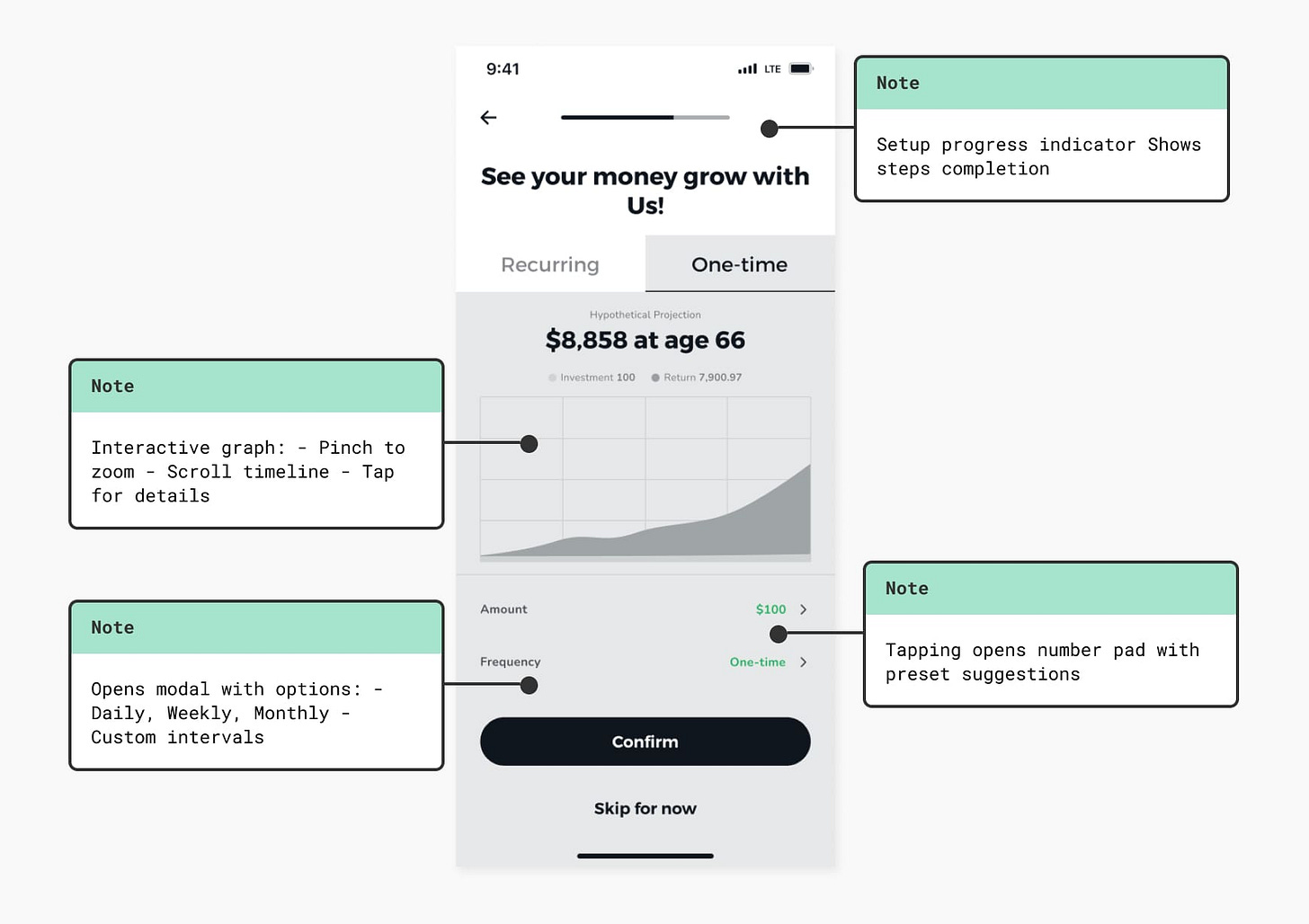When I was breaking into UX design in 2013, I voraciously ate up every blog on the topic.
One designer’s words stood out to me: Whitney Hess.
She wasn’t just handing out UX tips; reading her felt like an older sister of design sharing hard‑won wisdom with warmth.
One post she wrote stopped me dead in my tracks:
“The UX Career Path: From Wireframes to Coaching.”
I was just 2 years into UX design, which was at an inflection point to explode in 2014…to find out my internet mentor’s moving away from design.
I’m not sure whether I made up Whitney’s words as I ingested the story of her career journey, or if Whitney has since edited her blog post.
But I remember she said somewhere that a mantra for her career transition was:
“No more wireframes.”
It wasn’t that she was against wireframes or leveraging the classic tools of UX work.
It was simply to make space for a new role and self evolution.
Now, enter this wandering piece on the rise and fall of wireframes, going slower, and what we might borrow from lo-fi tools to inspire our careers.
The first half of my UX career felt eerily similar to Whitney’s.
I got into UX, created educational content on UX design, and did so much UX career coaching that I got sick of looking at portfolios and resumes.
Accidentally, I found myself doing less wireframes over time. I name 3 reasons:
Figma and multiplayer design tools made collaboration easier, to the point that making wireframes seem relatively that much more painful, and antiquated.
Not an industry-wide reason, but I transitioned from UX to content design. For me, that meant less visual design and more UI copy documentation.
Most mature design teams have design systems with ready-built components. Add AI advances to this, and that makes designing even faster. Why waste time on wireframes?
I don’t miss the days of painstakingly annotating “wireflows” and exporting them to PDFs for executive meetings.

BUT! But but but…
I wonder if it’s time to bring wireframes back. And not for the reason you might think.
Fast, slow, high and low
The original point of wireframes was to focus on the architecture of a digital experience.
Wireframes were often black and white and had placeholder elements. This was to focus the discussion on strategy, usability and experience versus being distracted by a sizzlin’ Unsplash picture.

As the UX industry matured, many designers hated the word mockup.
If we wanted to get a seat at the table (executives, business, strategy), then we needed to move from being viewed as a roled that produced design assets to one that created a user experience anchored in strategy.
That was the philosophical tension with wireframes. A lot of design shops looked at wireframes as the “assets” to “produce” for their “end clients.” That’s what you bill for.
But it’s really the thinking and philosophy behind wireframes that matter:
Slow down to go fast.
Wireframes were just a popular tool for of going low fidelity - using simplicity to focus on high level questions and problems.
AI slop and a call for slowness
We’re squarely in the use AI for everything! era in the corporate world, especially if you work in tech.
Designers now constantly face the existential question of whether they will be replaced with AI, which I’ve tried to answer in a previous newsletter.
But just because something can be generated faster, doesn’t mean it’s better:
It doesn’t matter if you can vibecode UIs in minutes if the design lacks a strategy.
End-users are still the final say. If you generate something faster using AI, great. But do users love it? Does it convert?
The better and faster that tools get, the more that human discernment, will, and taste become important.

When AI seemingly accelerates everything, include design processes, I think the smartest HIPPOs in the room can benefit everyone by slowing. the. fuck. down.
I once worked on a user flow that was particularly complex, rife with legal implications (#fintech). Opinions everywhere: should we break the experience up more into a carousel, or will users scroll?
The problem was that we all poured a lot of time into making shiny designs in Figma with all the components in there.
I took a step back and did content wireframes. Just low fidelity boxes and arrows and the main “theme” that specific piece of UI needed to communicate.
Everybody loved it. Going low fidelity seemed to have helped.
While wireframes may be out of fashion, we may still gain a lot from going slow ‘n lo.
Everything retro is cool again
Vinyl records, film cameras, and typewriters are all relics that have made roaring comebacks.
I wonder if wireframe - or at least lo-fi design tools - will fit the same pattern.
Remember Iron Man 3, when Tony Stark loses his high‑tech suits and holes up in a small-town garage?
Stripped of gizmos, he hacks together armor from hardware‑store scraps and rediscovers first‑principles engineering.
Lo‑fi approaches do the same for design, and maybe even our careers.
Nonlinear career paths
For designers in tech, the career path was usually “up or out.”
If you were an IC and didn’t get promoted to management, then your job was at risk. (Thankfully, that is changing).
But no one said career paths have to be linear.
Whitney Hess went from designer → coach
Many design industry veterans like Jake Knapp or Andy Budd → investors
Unironically, I say that with AI, many more designers may become → founders
I’m pursuing work-optionality by investing aggressively (hence, Money for Humans)
This is an odd comparison, but I see a parallel between what people go through with their careers, and the rise and fall (and continuing legacy) of wireframes.
Wireframes may drift in and out of vogue, but Whitney Hess’s real message was permission to evolve.
What’s your “no more wireframes?” Some prompts:
If you’re feeling inspired, try these lo-fi approaches to evaluating your career:
1. Your “No more” list:
No more ______.
Naming what ends is how possibility begins.
Write 5 tasks that drain you and 5 that give you. most energy. Circle which one’s you’d like to retire and which ones to make more space for.
2. Lo-fi day
Leave the phones and head to the park. Maybe bring something to sketch and write with. Observe what surfaces when you replace perfectionism wit simplicity.
3. Share it with someone.
Share your "no more ______" with a friend and discuss. Or you can share it with me:)
Reply to this email or leave a comment on Substack!
Whether you end up coaching, funding, managing, or writing newsletters like me, may you wield (or ditch) every tool just long enough to rediscover what’s possible.
Get low,
who also pontificates about careers in his other newsletter:



![Iron Man 3 (2013) [REVIEW] | The Wolfman Cometh Iron Man 3 (2013) [REVIEW] | The Wolfman Cometh](https://substackcdn.com/image/fetch/$s_!NwIx!,w_1456,c_limit,f_auto,q_auto:good,fl_progressive:steep/https%3A%2F%2Fsubstack-post-media.s3.amazonaws.com%2Fpublic%2Fimages%2F65f94bfd-2b84-4b15-bea8-1d18afa2a7ad_1600x1066.jpeg)

